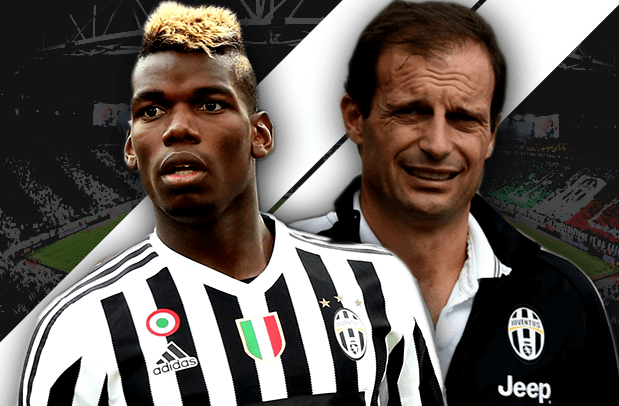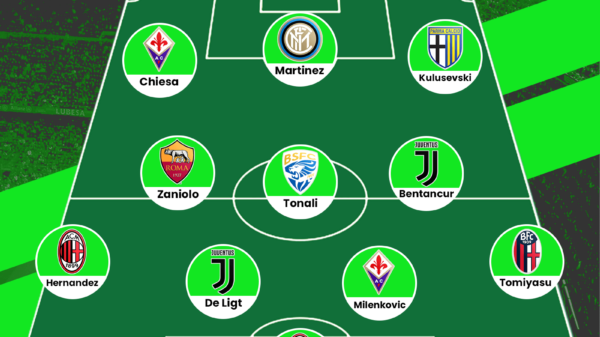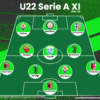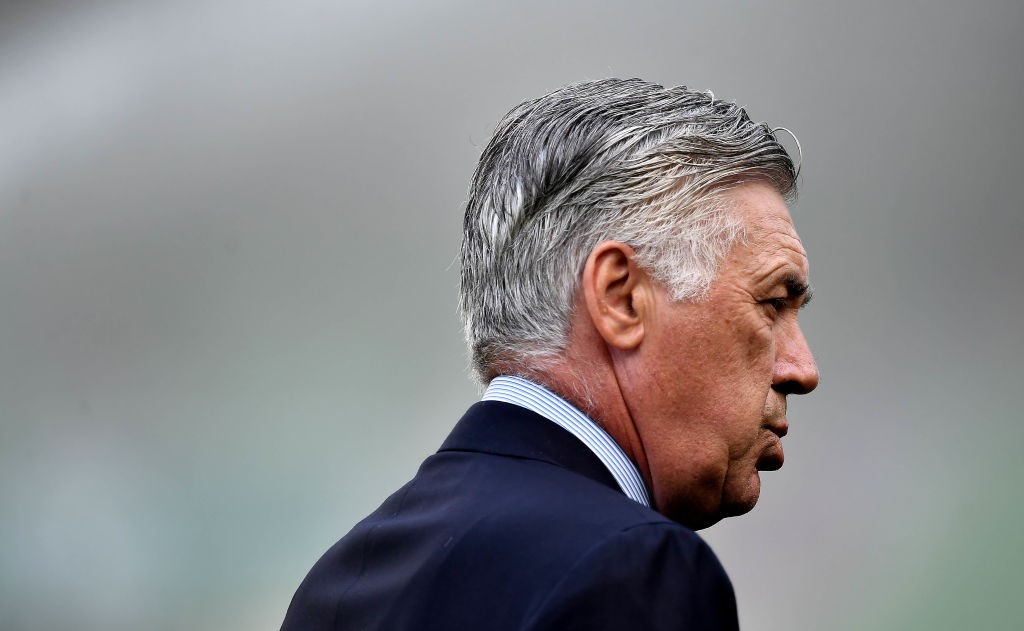Reigning Serie A champions Juventus have had an indifferent start to the season, losing their opening two fixtures. Flavio Fusi, in his debut article for us, writes about how the Old Lady has stuttered during their build up phase.
Last season Juventus had one of the best seasons in their history, winning a fourth consecutive Serie A title, the Coppa Italia and coming only a step away from Champions League glory. The Bianconeri midfield was pivotal in their success: Andrea Pirlo led the likes of Pogba, Marchisio and Vidal, all definitively consecrated as world-class midfielders.

Unfortunately, during the summer, Juventus lost three essential pieces of their “midfield puzzle”: the Regista par excellence, Andrea Pirlo flew to New York City, Arturo Vidal joined Pep Guardiola at Bayern Munich, while Carlos Tevez, the workaholic striker who consistently provided links between attack and midfield, chose to come back to his old club, Boca Juniors. Furthermore in addition to their on pitch contribution, these three players were basic in Juve dressing room for their charisma and natural leadership.
Since last year, Allegri chose Marchisio as Pirlo’s heir, and with the 36-year old playing only 20 Serie A matches, Marchisio frequently took the playmaker role. Previously a box-to-box midfielder in Juventus system, Marchisio adapted with relative ease to his new role in the heart of the midfield. Of course his qualities are different from Pirlo’s, but as Allegri already proved during his AC Milan spell, he prefers a more dynamic ball-winner and distributor. Mark van Bommel was, for example, on the Rossoneri bench when he won the Scudetto. Also, in his UEFA pro thesis, Allegri described the characteristics of a 3 man midfield, and Marchisio perfectly fits in the description of the player he wants in front of his defence.

The newcomer from Marseille, Mario Lemina, will be Marchisio first back-up in the Italian manager mind.
Vidal’s substitute, at least numerically, should have been Sami Khedira, but the German midfielder got injured in the friendly match against Olympique de Marseille, and he will be out at least until October.
The offensive midfielder Allegri wanted, a true requirement during the summer transfermarket arrived only on the last available day. After chasing the likes of Oscar, Mario Gotze, Julian Draxler and secretly even Marek Hamsik, Juventus sporting director Giuseppe Marotta got Hernanes from FC Inter, but when Juve had already played their first two Serie A games, losing both. However also Cuadrado joined on loan from Chelsea, giving Allegri a great weapon to dismantle opposing defences, yet not a player easily adaptable to his 4-3-1-2: the Colombian gives his best as a winger, but in Juventus set-up should play as the wide-midfielder/wingback in the 3-5-2, even if someone hinted that Allegri will try to convert the ex-Fiorentina player in a central midfielder.
In Juventus’ plan,Carlos Tevez successor is another Argentinian, Paulo Dybala, who joined the Bianconeri from Palermo for a reported fee of € 32 million plus additions. Last year, the left-footed young striker, had a breakthrough season in Palermo scoring 13 goals and dishing 10 assists. At Palermo, Dybala played as the lone striker in Giuseppe Iachini’s 3-5-1-1 system, with Franco Vazquez behind him. Now in Turin he will have to learn Tevez’ second striker role, still a work-in progress task, and maintain his scoring contribution, like he has done in his first two full matches, in which he has already scored twice. Incidentally, those were the only two goals Juventus have scored this season.
But in football it’s almost impossible to replace the spine of a team and to play well straight away. So far, after three games with only a point on the table, Juventus recorded their worst start in the Serie A since 1968/1969, a season in which the Bianconeri ended up in second place behind Inter. Lack of fitness, injuries (particularly Marchisio’s and Morata’s) had an impact in Juventus struggles, but overall midfield contribution, especially in build-up, was the most undeniable of Juventus problems.
Last Year Juve built up play with ease both with the 3-5-2 and the 4-3-1-2: even if the shape and the players involved were different, the contribution of the deep-lying playmaker was pivotal. In the 3-5-2, Bonucci was the deep vertex of the diamond set up together with Barzagli, Pirlo (or Marchisio) and Chiellini. The diamond was shaped near their penalty area, and it was kept until the opposing half, when the playmaker was more free to roam, while the three defenders maintained their line near the centre circle, usually helped by the wingback opposite to the side where the game was developing.
When Allegri deployed the 4-3-1-2, the Italian manager implemented his own version of the notorious “salida lavolpiana”: Pirlo (or Marchisio) dropped in between the two widening centre-backs, setting up a triangle this time, with Bonucci on the right and Chiellini on the left, while the fullbacks positioned themselves higher up the pitch. In this situation one of the other midfielders (if not the offensive midfielder, Vidal) dropped deep to receive the ball. Ideally, if Tevez or Morata shifted closer to the midfield, in a no.10 position, was Vidal to move higher in the forwards zone.
Otherwise Juve players were able to take a more direct approach, with Pirlo or Marchisio playing a direct pass to the dropping forwards, breaking opposing lines of pressure.
With so many important players gone, the newcomers who still have to fully adapt to their new club and with Marchisio and Khedira injured, Juventus had to take a new approach in build-up, but they had slightly different issues in each of the three games played so far and we will analyze them match by match.
Juventus 0-1 Udinese
Allegri chose the 3-5-2, with the surprising choice of Padoin in an unprecedented no. 6 position. A hard-working and multi-positional footballer, Padoin was very useful both under Conte and Allegri reigns, but he hasn’t the playmaking ability required, so Bonucci had to step up. Practically, during Juventus deep-build up play, the central defender took both his and ex-Pirlo’s roles in the diamond described above, moving in and out from the defence.
Padoin had clear difficulties in his brand new role: he was often too distant or too near from Bonucci and he roamed (or better, wandered) in the middle of the pitch. Moreover, Udinese energetic midfield trio of Badu, Iturra and Fernandes consistently pressed him, magnifying his problems.
Bonucci was Juventus real playmaker, but he was also Juventus last man in defence and he couldn’t push higher than the centre of the pitch, so advancing playmaking duties were on Pogba’s shoulders. The French was really proactive in receiving the ball and in negating ball access to the opposition, but he can’t dictate the tempo of his team, especially from his position as left-central midfielder. From that spot, he is very good in creating chances with diagonal passes that have the advantage of cutting both horizontal and vertical lines of the defence, while both gaining space and switching play. Unfortunately against Udinese 3-5-2, which turned in a 5-3-2 in the defensive phase, options to play this kind of passes were sporadic. Coman had to come deep to get the ball a lot, leaving Mandzukic alone against three (if not five) defenders and Juve only option seemed to play cross after cross after cross.
Roma 2-1 Juventus
With Marchisio still out, Allegri deployed again the 3-5-2, with the same midfield of the first match. Dybala made his debut as a starter for Juventus, in place of Coman who joined Bayern in the meantime.
Roma had a clear edge on midfield and on the ball since the start of the game, with Juventus midfielders unable to maintain possession. Padoin once again tried to give his best, but he is not suited to play in a role that is so vital in football. In addition to his natural struggle, Edin Džeko man marked or cover-shadowed him all the time, cutting links between Juventus defence and midfield.
Padoin was de facto excluded from Juventus build-up: in his 71 minutes on the pitch he played only 27 passes, while his substitute Roberto Pereyra had 23 passes in less than 20 minutes.
Once again Bonucci took more playmaking responsibilities, but with the pressing of Roma forwards he had less freedom if compared with the first match against Udinese. Juventus played a lot of long balls towards Mandzukic, bypassing the midfield: they played a total of 355 passes, with 43 of which being long balls, an average of a long ball played every 8 passes.
Understanding lacked in Dybala and Mandzukic striker partnership: Dybala tried to move towards the midfield with the aim to offer a passing lane to his team-mates, but a lack of movement of the Croatian and of the other midfielders, often forced Dybala to try a one-man effort or to play the backward pass.
Things got better with the entering on the pitch of Morata, Pereyra and Cuadrado: links in transition phase seemed re-established and Juventus even managed to score a goal, but was too little too late and they lost their second consecutive match.
Juventus 1-1 Chievo
International break could give to a manager possibility of work without the urge of game preparation, but that’s not Allegri’s chance. Juventus had not less than 12 players out on international duty, all featuring in every match played by their national teams.
For the second home match of the season, Allegri lined-up the 4-3-1-2, with Marchiso finally recovered and deployed in his playmaker role. Pogba sat on the bench, while Hernanes debuted behind the strikers.
During the first half Chievo was very aggressive and pressed Juventus in their half. Rolando Maran switched from his usual 4-4-2 to a 4-3-1-2: during the defensive phase Birsa joined the forwards Meggiorini and Paloschi to press in a 4-3-1-2/4-3-2-1 shape. One of them controlled the centre, trying to cover-shadowing Marchisio, while the other two oversaw the half-spaces, putting pressure on the central defender on the ball and forcing Juve to the play the ball to the flanks.
Juve didn’t play well in the first 45 minutes and were unable to supply the ball to their strikers. Even if not fully fit, Marchisio was way more comfortable than Padoin in the centre of Juve midfield, but unfortunately he got injured once again and his performance worsen. He completed the first half but had to give up, with Pogba substituting him during the interval.
Juventus was once again without his playmaker. Allegri switched to the 3-5-2, with Caceres shifting up in defence, Sturaro on the right flank (then substituted by Cuadrado) and Hernanes moving from his offensive midfielder position to Marchisio’s spot in front of the defence.
Hernanes didn’t drop consistently to aid build-up play from the back like Marchisio, but with Chievo gradually dropping deeper and switching to a 4-5-1 there wasn’t a compelling need to do so. He took turns with Pereyra in dictating the tempo, with both roaming a lot. The Bianconeri lacked a reference in the middle of the pitch and their tempo was often slow, yet Chievo’s approach made them play better: they managed to level things up with Dybala penalty-kick.
Conclusion
The new injury that has happened to Marchisio has once again left Juventus without a playmaker for at least a month, and is anything but good news considering how important he is for Juventus’ style of play. The first three Serie A games have proved how hindered Juventus are in their build-up, especially from deep.
Written by Flavio Fusi
- Goal Analysis: BATE Borisov 3-2 Roma | Slack opening costs the away side - October 2, 2015
- Analysis: Juventus’ struggles in midfield and the build-up phase - September 17, 2015



































































